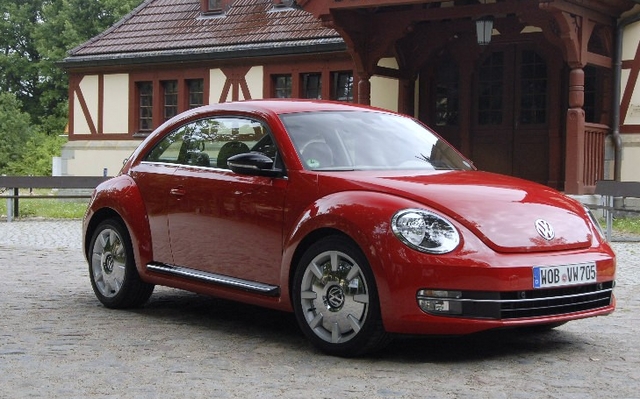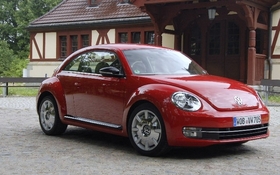2012 Volkswagen Beetle – Guaranteed fun

| Strong points |
|
|---|---|
| Weak points |
|
Following April’s spectacular simultaneous unveiling in Berlin, Shanghai and New York, the time has come to test drive the third generation of the Beetle. We got the chance to get behind the wheel of this newcomer during a special event that took place in Berlin, Germany. Of course, as is always the case at these unveilings to the international press, you don’t always get to drive a model that corresponds exactly to what is going to be sold on our market, so all of the models available to the press at the presentation were versions equipped with the 2.0-litre 200-hp engine. The only choice we had was between the European or North American model. The first part of our test drive, a 200 km loop north of Berlin, was in a European version with sport suspension. Be forewarned, the photos that accompany this text are of the European version. Note that the chrome wheels will not be offered in Canada. Moreover, some of the dashboard and the exterior presentation details are not in keeping with the Canadian models. Next, we drove a North American version and noted that the ride is similar to that of the European version. Only the layout and the presentation differ.
It’s all about the shape!
When you produce a car as emblematic as the Beetle, straying from the beaten path is frowned upon. And dare not change so characteristic a shape for fear of being banished from the world of Volkswagen forever. Sure, the second generation had the original shape, but it was a little too cartoonish. Function was dependant on form, when normally the opposite is true.
The third Beetle has a silhouette that respects the original version, but the shapes were revised in order to make the vehicle more practical. That’s how the curve of the roof came to be a few millimetres flatter, which helped give the shape more balance and offer more headroom for the passengers in the backseats. A manager at Volkswagen admitted to us that the comfort in the backseats could now be considered tolerable, while only children could say the same with the New Beetle. Although the head room is improved, leg room is still so limited that if you want to ride in the back seats of this Volkswagen, those in the front seats will have to cooperate. The front seats are very generous however, and they offer lots of elbow, leg and head room.
The previous version’s dashboard was very deep and the occupants of the front seats were very far from the windshield. That’s a lot of space to lose just to say faithful to aesthetics... The revised silhouette helped bring the dashboard a lot closer to the windshield. Not only is it more elegant, but it’s more practical as well. Among other things, there’s a glove compartment situated on the front of the dashboard, just like it was on the original version. Note that there’s another storage compartment located in the lower part.
There are three indicator dials facing the driver. The largest and most important is the speedometer, located dead centre. In its lower part, there’s also an information centre. The controls are simple, easy to access and user-friendly, and it has several features borrowed from other Volkswagen products. Regardless of the trim level you choose, the front seats are comfortable and offer excellent lateral support. What’s more, the seats have great thigh support. Also note the stellar driving position and nice, very large foot rest. Finally, the quality of the materials is excellent, as is the assembly. Another improvement compared to the old generation is the trunk, which is not only easier to access thanks to its larger hatch, but it has a greater loading capacity. With the rear seatback up, it has a 310-litre capacity, which expands to 905 litres once the 50/50 seatback is folded down.
A trio of engines
As mentioned previously, only the four-cylinder 2.0-litre TFSI engine producing 200 hpwas available. It was paired with a six-speed dual-clutch automatic transmission. This engine equips the Sportline, which claims to be the most luxurious and sportiest version in the family. The other engine that will be available once this model arrives on our market will be the five-cylinder 2.5-litre featuring 170 hp. It comes factory standard with a five-speed manual transmission, while the single-clutch automatic is a six-speed. Over the next year, it will also be possible to order this Beetle with its famous 2.0-litre turbo diesel and 140 hp.
While the Sportline model stands out with its more powerful engine, you should also note that this car is equipped with an independent rear suspension and disk brakes on all four wheels. The other versions are equipped with a rear torsion bar suspension, while the rear wheels are fitted with drum brakes. As for the rest, the car is very well equipped and the electronic driving aides are present and accounted for.
The real test
It’s true that the shape has been changed, the dashboard is more practical and the general equipment is more complete than before. The bad news for some is that the flower pot attached to the New Beetle’s dash has disappeared. Of course, that has no impact whatsoever on roadholding or handling, but still, there are those that will be saddened by the news...
After a few hundred kilometres on side roads, the Autobahn and intense Berlin traffic, the result is very positive. Firstly, the large exterior rearview mirrors guarantee excellent rear visibility. However, if you’re one of those people who only uses the interior rearview mirrors, you’ll find the rear visibility somewhat lacking. A relatively light car powered by 200-hp engine definitely makes for accelerations and pick up that can be considered sporty. It goes from 0-100 km/hr in 7.2 seconds. What’s more, upshifting or downshifting using the stick is a delight, and helps take advantage of the shifting speed of the dual-clutch transmission. On the North American version we tested, there were wheel-mounted paddle shifters.
But this car’s stability, the precision of the steering and its solid handling in turns with practically no body roll are what’s most impressive. Basically, it’s a Volkswagen that behaves like a real Volkswagen. However, there are a few little problems. For starters, the brakes are very hard gat adapted to. No sooner do you touch the brake pedal than it gives the car a jolt. Furthermore, at certain times the engine vibrated slightly, as though the automatic gearbox was shifting too early. It’s barely noticeable, but it’s better that you’re made aware of it now.
In conclusion, this time, the Beetle isn’t a cute little car inspired by one of the bestselling cars of all time. It’s a well designed coupe that’s well put together and features impeccable handling. Oh, and I almost forgot: the optional Fender audio system with a 400-watt amp lives up to its reputation with a muscular and dynamic output.
As part of the launch this fall, Volkswagen Canada will offer two special versions, the Premiere and Premiere +, with better equipment for the price. In both cases, these cars are available in very small quantity and will be equipped with a five-cylinder 2.5-litre engine and the six-speed automatic transmission.











